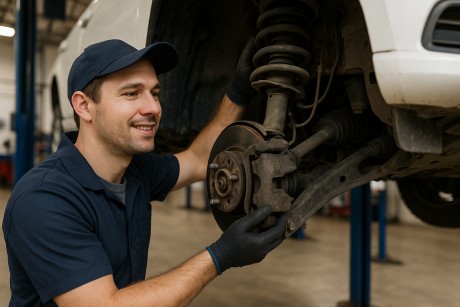You understand the experience of driving your vehicle across the newly resurfaced pavement, where the vehicle moves with exceptional ease. It’s smooth, quiet, and comfortable. The suspension system of your car produces that pleasant riding experience. A network of springs and shocks alongside linkages operates beneath your seat to provide stability and absorb all impact that comes your way. People tend to notice the convenient features of their suspension only after it starts generating discomforting sounds.
The road conditions in Canada attack our vehicle suspensions to the point of fatigue. Ice-cold seasons coupled with extensive temperature fluctuations contribute to the formation of devastating roads, a combination of which creates excessive wear on vehicles. Spending time on suspension system maintenance enhances more than smooth drivability. Safety depends heavily on suspension function because it governs both steering capabilities and braking performance, as well as tire traction on slippery surfaces. Reading through proper suspension care methods enables us to make both systems and safety conditions last longer.

Understanding Your Vehicle’s Suspension System
Before discussing the detailed aspects of maintenance, we need to establish what matters we will address. The core function of the suspension is to link wheel movement with the car body structure through frame connection. The suspension system primarily exists to control how tires interact with surfaces of the road. To provide smooth driving conditions, the suspension system must handle various road obstacles, such as potholes and natural irregularities of the terrain. People normally pay attention to this aspect.
While designs vary, the main characters usually include springs – these could be coil springs (like a sturdy Slinky), leaf springs (common on trucks), or torsion bars. They handle the big job of supporting the car’s weight and absorbing the initial jolt from bumps. Then, you have shock absorbers (also called dampers) or struts. Springs alone would just keep bouncing, making the car feel like a boat on a rough sea. Shocks/struts control bouncing, turning movement into heat and providing stability.
Connecting all these are various arms (like control arms), bushings (little rubber or synthetic cushions that absorb vibration and allow controlled movement), and ball joints (which act like shoulder joints, allowing the wheels to move up/down and steer). It’s a complex dance, and all these parts need to work together harmoniously.
Signs of Suspension Wear
Your car is pretty good at communicating when something’s wrong, although sometimes its language is a bit… percussive. Learning to recognize the signs of suspension trouble can save you bigger headaches later. Here are some common SOS signals:
- The Bouncy Castle Effect: This is a dead giveaway. You hit a bump, and instead of settling quickly, the car keeps bouncing or feels excessively floaty. It might even feel like it’s swaying side-to-side after a bump.
- Weird Noises – Clunks, Rattles, Squeaks: Uh oh. Hear a heavy clunk when you hit a pothole? Maybe a rattling sound from one corner on the rough pavement? Or perhaps a persistent squeak or groan when turning or going over speed bumps? These noises often point to worn-out components. Clunks could be bad ball joints or loose strut mounts. Rattles might be sway bar links.
- The Car Wanders or Pulls: Do you feel like you’re constantly fighting the steering wheel to keep the car straight? Does it want to drift to one side on its own? While this can be an alignment issue, pure and simple, worn suspension parts (like bushings or ball joints) are very often the cause of that alignment problem.
- Uneven Tire Wear: Take a good look at your tires. Is the tread wearing down evenly across the width? Or are the inside or outside edges wearing much faster? Maybe you see scalloped or “cupped” patterns?
- Nose-Diving or Squatting: When you hit the brakes firmly (but safely!), does the front end of the car dip down dramatically? When you accelerate, does the rear end seem to sag?
- Just Feels… Rough: Sometimes, it’s less specific. The ride just isn’t as smooth as it used to be. You feel every little imperfection in the road jarringly.
- Visible Damage or Leaks: Occasionally, the problem is obvious. Get down and look. Are the shock absorbers or struts oily or wet? That means their seals have failed, and they’re leaking fluid – they need replacing. Can you see cracked or broken rubber bushings?
To dive deeper into the signs that your car’s suspension system might be in trouble, check out our article on What Are the Signs of Car Suspension Problems?
Suspension Maintenance Tips
Okay, enough about problems! Let’s talk about solutions and prevention. Good suspension system maintenance isn’t overly complicated.
Regular Inspections
Being proactive is the name of the game.
- Your Own Quick Checks: You don’t need a hoist or fancy tools for a basic check. Regularly check your tire pressures – seriously, this is maybe the easiest and most impactful thing you can do. Underinflated tires put huge stress on the suspension. Use the pressure listed on your driver’s side door jamb sticker, not the max pressure on the tire sidewall.
- Professional Eyes: When your car is in for service (oil change, tire swap – hello, Canadian spring/fall ritual!), ask your mechanic to specifically inspect the suspension components. They can put it on a lift, check for looseness in ball joints and tie rods (critical steering parts often considered part of the suspension check), examine bushings for cracks, inspect shocks for leaks, and look for any other signs of wear or damage. An annual check is a good baseline.

Driving Habits That Damage Suspension
Let’s be real: how we drive significantly affects the lifespan of our car suspension. Our Canadian roads throw enough challenges at us; we don’t need to add insult to injury.
- Pothole Dodging (When Safe!): Those craters that appear after winter are suspension killers. Hitting one sharply, especially with a wheel turned, can bend rims, damage tires, wreck alignment, and severely shock suspension components. Scan the road ahead. Slow down if you see rough patches.
- Respect the Speed Bump: They aren’t suggestions; they’re there for a reason. Flying over them sends a huge shock load through the system. Ease up before you get to them. The same goes for railway crossings and sharp dips. Gentle inputs are key.
- Curbs are Not Your Friends: Scraping against curbs while parking or, worse, hitting one directly is bad news. It can instantly ruin your alignment, damage tires or wheels, and potentially bend suspension parts like control arms or tie rods. Take that extra second to park carefully.
- Don’t Overload: Your vehicle has a specific payload capacity (check your manual). Regularly stuffing it to the gills with heavy cargo or too many passengers puts a constant strain on the springs, shocks, and bushings, making them wear out much faster. If you often haul heavy loads, maybe you need a vehicle with a beefier suspension setup.
Preventing Suspension Damage
Beyond driving style, think preventatively.
- Alignment is King: Wheel alignment ensures your tires are pointing in the right direction relative to each other and the road. When it’s off, the car might pull, tires wear unevenly, and suspension parts are stressed.
- Keep it Clean(ish): Road salt is brutal. That stuff cakes onto your undercarriage and accelerates rust on metal suspension parts, bolts, and brake lines. Rinsing the underside of your car occasionally, especially after winter storms, can help wash away corrosive salt and grime.
How to Protect Your Car’s Suspension
Ultimately, protecting your suspension comes down to awareness and timely action. Listen to your car. Feel how it drives. Investigate unusual behaviour promptly. Don’t put off repairs just because the car still moves. One worn part can often cause a chain reaction, damaging other connected components. When repairs are needed, using quality parts makes a difference in how long the fix lasts. Think of it like preventative health care – a little effort now saves potential pain (and expense) later.
How Often to Inspect Car Suspension
There’s no single magic number, but here’s a sensible approach:
- Check the Book: Your owner’s manual often gives manufacturer recommendations for inspection intervals. Start there.
- Annually is Smart: A thorough check by a mechanic once a year, or maybe every 20,000-25,000 km, is a widely accepted guideline. Tying it to your seasonal tire changeover is a convenient reminder for many Canadians.
- After Impacts: If you hit a truly nasty pothole or slide into a curb, it’s wise to get things checked soon after, even if it seems okay. Hidden damage can occur.
- When it Feels Wrong: This overrides any schedule. If the car starts making new noises, handling oddly, or exhibiting any of the warning signs we talked about, get it inspected right away. Don’t wait.
Suspension Repair Tips
So, the mechanic confirms it: something needs replacing. What now?
- Don’t Delay (Usually): While a slightly weeping shock might not be an immediate emergency, clunking ball joints or severe pulling are safety concerns.
- Quality Parts Pay Off: Discuss options with your mechanic. OEM (Original Equipment Manufacturer) parts are made specifically for your car but cost more. Good quality aftermarket parts from reputable brands (Monroe, KYB, Moog, etc.) can be just as good, sometimes better, and often more affordable.
- Pairs are Best (Often): Shocks and struts should almost always be replaced in pairs (both front and rear). Replacing just one can lead to unbalanced handling and unpredictable responses.
- Trust Your Mechanic: Suspension work can involve specialized tools (like spring compressors – very dangerous if misused!) and requires knowledge of torquing bolts correctly.
- Alignment, Alignment, Alignment: Yes, again! After replacing struts, control arms, ball joints, or tie rods, a four-wheel alignment is essential. Skipping it basically guarantees poor handling and rapid tire wear. Budget for it as part of the repair cost.
Ready to Give Your Suspension the Care It Deserves?
The maintenance of a vehicle suspension stands as one of the least glamorous duties that car owners must handle. Replacements of struts do not spark anyone’s enthusiasm. Understanding the physics behind suspension systems combined with proper maintenance, attentive driving habits, and scheduled inspections will help your car achieve a much longer service life.
Need professional help with your suspension? Visit our Car Suspension Repair Service page to get expert care and restore your vehicle’s smooth, safe ride.
What are the common signs of suspension problems?
Common suspension issues generate four different sets of symptoms: the vehicle becomes bouncy or floaty after bumps, produces clunking/rattling/squeaking noises from beneath it, pulls toward one direction, wears tires unevenly or quickly, provides a harsh ride and results in excessive nose-diving upon braking and squatting when accelerating while possibly manifesting fluid leaks from shocks/struts.
Can I drive with a worn suspension?
The car operates, but significant suspension wear makes driving conditions unsafe for all passengers and drivers. The condition of the suspension leads to poorer handling and compromised stability while increasing the time for braking. A ball joint failure during normal driving operation could cause the vehicle to lose its ability to steer. Addressing suspension problems right away remains essential because of safety concerns.
How much does suspension repair cost?
Repair expenses for automobile suspensions across Canada exist in a wide price range. The cost depends on your vehicle’s type (European or truck section) and required parts (bushings are more affordable than struts), as well as labour rates and the part’s source type (original equipment or aftermarket). The amount required for suspension repairs spans from several hundred for minor work to more than $1500 when you need to replace key components such as struts together with post-fixing wheel alignment.

